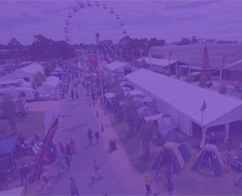
Sydney
June 21-22, 2025
Sydney Showground Olympic Park



Upon its release in 1979, Mad Max changed everything for Australian cinema.
Stars Steve Bisley (Max’s right-hand man, Goose) and Hugh Keays-Byrne (Toecutter in the original, and then Immortan Joe in Mad Max: Fury Road) look back on the iconic release ahead of their fast-approaching appearance at Supanova in Perth.
Are you looking forward to getting back to Supanova?
Steve: It’s been great to touch base with some of the rusted on fans. And I guess [Fury Road] has given the whole franchise a bit of a kick along, too. There’s real dedicated fans for the first one. There’s a lot of people out there with replica cars and bikes and who are just crazy for the film.
Hugh: Yes, indeed. I can’t wait to get back. [Melbourne and Gold Coast] were wonderful, absolutely wonderful. I thoroughly enjoyed it. Everybody was nutters and it was perfect. Just everybody in their costumes and everybody with their enthusiasm.
How does that 40th-anniversary milestone feel?
Hugh: Extraordinary. I can’t actually believe that people are still talking about it and here we all are. I mean, it’s unusual to say the least, of a little film that emerged and then was massive, and then the next one was massive, and then the next was a bit sort of mmm… And then I was doing number four and I can’t believe that. People couldn’t believe I was still alive. And that was all very sweet because they were all younger people, and yeah, 40 years is a long time.
Steve: I’ve worked it out – I’ve got to double the time where I think I’ve done the job. I’ll think, ‘Water Rats is probably 10 years ago,’ and it’s like 20. ‘Mad Max’ is 20 years ago – it’s 40. So I think if I double the time I think back to when I did it, I’m about right. But it feels like no time at all.
Thinking back to filming, what stands out the most?
Steve: I can remember every day on that film. I’ve got pretty good recall. I think I probably had to develop that over time, you know, in terms of performance. But I can – it’s so vivid. I think that a few things come into play there; it was such a unique experience. If I look back at all the things I’ve done, it’s a bit of a stand out because it was breaking new ground in terms of the style of film that was in Australia at the time. There hadn’t been anything [like that] and I don’t think there has been anything [like it] since.
If you look at it now, in my eyes, and I’m sort of close to it, it doesn’t feel dated at all. Remember, there’s no CGI, so everything you see is what we did, there’s no computer-generated stuff at all. For its time, it’s a pretty amazing piece to have pulled off.
Hugh: Probably the motorcycles, getting to work, cold mornings – those sorts of things. Also an immense excitement, but I was there for such a short time. I think I was there for three weeks, at the most.
It was very, very quick, and in and out and very edgy and like, ‘Oh my god, is this actually going to come off? Is this going to come out? Is this going to work?’ Because, I mean, it was very, very exciting to be part of, but it was also pretty unorganised because of the, well, just lack of budget. There was just a caravan, which you could sit in if it was raining.
Why do you think people connect so strongly with it?
Hugh: It’s hard to know, isn’t it? There was a woman who came up to us at one of these shows, and she’d been at Clunes when we were filming. So she was a 16-year-old girl who came up and got my autograph when we were filming in Clunes, and I mean, that was a pretty daring thing to do – come up to the Toecutter in full flight and have his autograph because I wasn’t a mild-mannered Toecutter, and I was sort of in character, as you would say, but anyway, she took the photo. And then, what, 40 years later, she turns up and says, ‘Hello, this is me. There’s the photo and you signed it and here I am now.’ And, she’s in her 50s, of course.
Steve: I think it’s just the unique quality of the film itself. Especially, and I’m a bit biased I guess, but when I look at it there’s this interesting sort of naïve energy in the first film, and I think that came about because a lot of the players in it, both Mel Gibson and I, were straight out of drama school. Hugh Keays-Byrne had only recently come to Australia and he had a big theatre background, and then George Miller, it’s his first feature film. It’s so unique in its character, so unique in its subject matter. It punches way above its weight, really way above its weight. I still think it’s a landmark film. I just think it shows what can be done here, I don’t think there are limitations on what can be produced here.
Steve Bisley and Hugh Keays-Byrne will appear at Supanova Comic Con & Gaming Sydney (21–23 June) and Perth (29-30 June).






